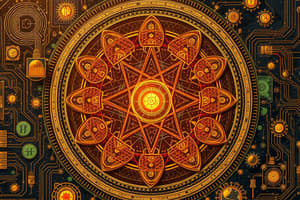Podcast
Questions and Answers
What is one method to strengthen an electromagnet?
What is one method to strengthen an electromagnet?
- Using air as the core material
- Increasing the voltage of the power source (correct)
- Decreasing the number of coils
- Using plastic as the core material
What do electric motors and generators primarily do?
What do electric motors and generators primarily do?
- Convert nuclear energy into mechanical energy
- Convert electrical energy into mechanical energy or vice versa (correct)
- Convert electrical energy into thermal energy
- Convert magnetic energy into chemical energy
How can the operation of an electromagnet be controlled?
How can the operation of an electromagnet be controlled?
- By changing the physical size of the electromagnet
- By increasing the temperature of the core material
- By altering the distance between magnetic domains
- By controlling the flow of electric current (correct)
What happens when a magnet is moved relative to an electromagnet?
What happens when a magnet is moved relative to an electromagnet?
Which material is considered highly magnetic for an electromagnet's core?
Which material is considered highly magnetic for an electromagnet's core?
What determines the elemental identity of an atom?
What determines the elemental identity of an atom?
What happens to the charge of an ion when it gains electrons?
What happens to the charge of an ion when it gains electrons?
Which component is essential in completing a circuit?
Which component is essential in completing a circuit?
Which statement is true about static electricity?
Which statement is true about static electricity?
What is the effect of resistance on current flow in a circuit?
What is the effect of resistance on current flow in a circuit?
What characterizes a short circuit?
What characterizes a short circuit?
Which of the following statements about magnets is true?
Which of the following statements about magnets is true?
Flashcards
Magnetic Field Strength
Magnetic Field Strength
The strength of a magnetic field is determined by the distance between the poles and the proximity of magnetic domains.
Electromagnets
Electromagnets
Devices that create magnetic fields by passing electricity through coils of wire wrapped around a ferromagnetic material.
Electromagnet Control
Electromagnet Control
Electromagnets can be turned on and off by controlling the flow of electric current.
Electromagnetic Induction
Electromagnetic Induction
Signup and view all the flashcards
Electric Motors and Generators
Electric Motors and Generators
Signup and view all the flashcards
Atomic Nucleus
Atomic Nucleus
Signup and view all the flashcards
Electrons
Electrons
Signup and view all the flashcards
Ions
Ions
Signup and view all the flashcards
Closed Circuit
Closed Circuit
Signup and view all the flashcards
Open Circuit
Open Circuit
Signup and view all the flashcards
Short Circuit
Short Circuit
Signup and view all the flashcards
Magnetic Domains
Magnetic Domains
Signup and view all the flashcards
Magnetic Force
Magnetic Force
Signup and view all the flashcards
Study Notes
Atomic Structure
- Atoms are composed of protons, neutrons, and electrons.
- Protons are positively charged.
- Neutrons are neutral (no charge).
- Electrons are negatively charged.
- An element's identity is determined by the number of protons in its nucleus.
Ions
- Ions are charged atoms formed by gaining or losing electrons.
- The number of protons and electrons in an ion is unequal, resulting in a net charge.
Non-Contact Forces
- Conservation of Charge: The total charge in an isolated system remains constant.
- Potential Energy (Electric Fields/Magnets): Electric fields and magnets affect the potential energy of charged particles.
- Current: Electron flow is electric current.
- Resistance: Resistance hinders electron flow, reducing current.
- Static Electricity: Accumulated electric charge on an insulator.
Circuits
- Circuits have three key parts: a power source, wires, and a load (e.g., light bulb, motor).
- Power source provides energy.
- Wires conduct current.
- Load consumes the energy.
Circuit Types
- Closed Circuit: A complete path for current.
- Open Circuit: A broken path preventing current flow.
- Short Circuit: A low-resistance path with excessive current.
- Parallel Circuit: Multiple branches with independent current flow.
- Series Circuit: Current flows sequentially through branches.
Magnetic Properties
- Magnetic forces arise from aligned magnetic domains.
- Opposite poles attract.
- Like poles repel.
- Permanent magnets maintain their magnetism.
- Induced magnetism occurs when a magnet moves near a conductor, creating an electromagnetic field.
- Earth has a magnetic field.
- Magnetic field strength depends on distance between poles and magnetic domain proximity.
Electromagnets
- Electromagnets generate magnetic fields via electric current in coils wrapped around a ferromagnetic material.
- Operation: Turning the current on/off controls the magnet.
- Mechanical-Electrical Energy Conversion: Moving a magnet relative to an electromagnet transforms mechanical energy into electrical energy.
- Strengthening Electromagnets: Increasing coil number, voltage, and using iron cores strengthens electromagnets.
Electric Motors and Generators
- Electric motors and generators convert electrical energy into mechanical energy, or vice versa.
- They share many components.
Studying That Suits You
Use AI to generate personalized quizzes and flashcards to suit your learning preferences.



